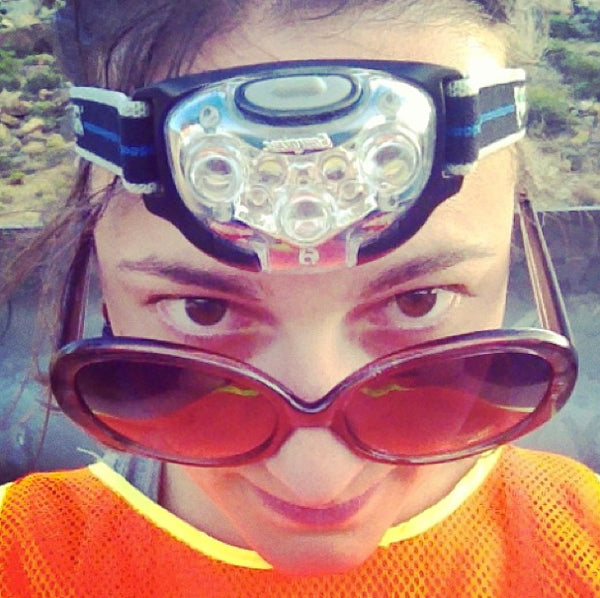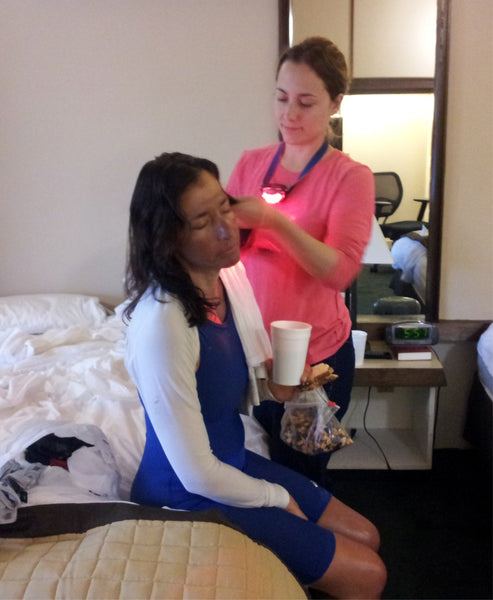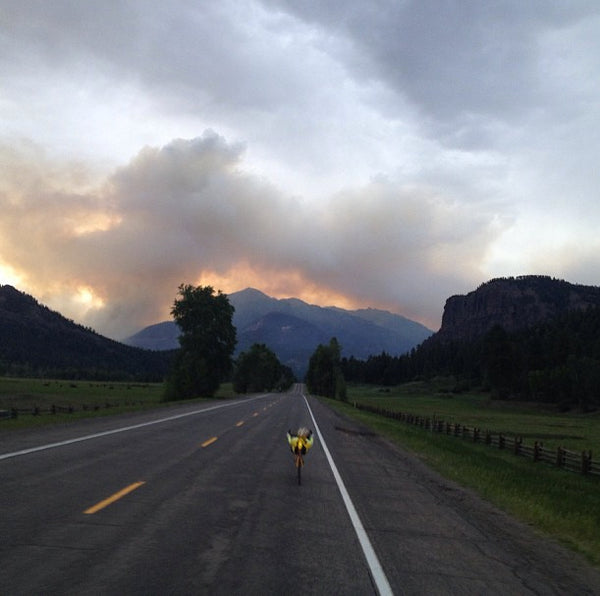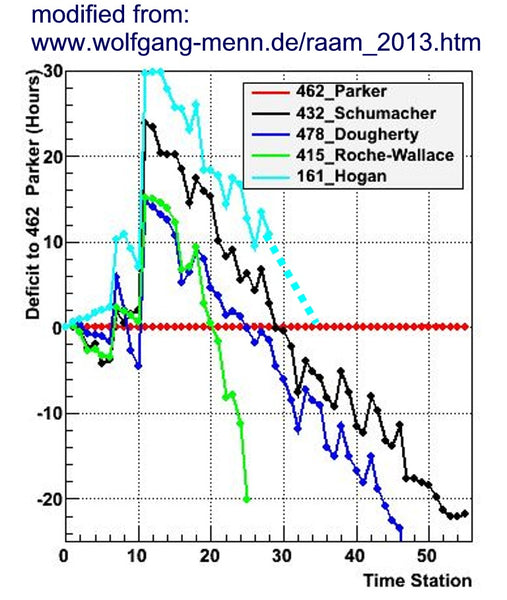RAAM Report Part 2: The Rockies and the Plains
July 9, 2013/ Jim Parker
“You’re joking, right?” was the reply from my daughter, Genevieve, when I told her that her mother, Maria, was back on the course near Tuba City and, once again, officially in the Race Across America.

Genevieve was back in Flagstaff with the rest of the crew, thinking the race was over, while Ted and I had just dropped Maria back on the course where she had stopped 24 hours earlier. Once we convinced her that indeed, it was true, we could hear shouts of joy from the rest of the crew. The energy level and excitement, which plummeted after the accident and the DNF, were back stronger than ever.
We needed that energy because we had a lot of work to do and fewer people to do it. The crew structure had to be reorganized. Until the Tuba City accident, we had three crews of three rotating through an 8-hour “follow” shift each day, and an independent media crew of three, setting their own schedule, in their own vehicle. The 3-person follow crew consisted of a driver, navigator, and feeder. After the accident, we initially switched to three crews of two and left the media crew intact. The 2-person crew seemed to work well at first, but as the shift dragged on, it became very burdensome for only two people to carry out all the tasks that were needed. We decided to incorporate the media crew into the support crew. This not only gave us the 3-person crews that we wanted, but eliminated the need for one of our two rental vehicles. We were always conscious of keeping costs down; which was a big reasons we opted not to use an RV. We had started RAAM with four vehicles, all owned by crew members. Then one was totaled in the accident, and the other was Dan’s which he needed to take departing crew members to the airport in Phoenix and to return to his home in Prescott. By embedding the media crew with the support crew, we eliminated an expensive rental vehicle and had the added benefit of better support for Maria and closer media coverage.
Genevieve, who traveled from her home in Ramallah (West Bank of Palestine) to be on the Media team, joined my crew as navigator, but her specialty was loving and caring for her mother’s emotional needs.
She had replaced Tammy Funk, a very good old friend of Maria’s.
{Below: Genevieve brushes her mom’s hair as part of her “wake-up” ritual.}

One of the risks of having close friends and family members as crew members is that they have trouble remaining emotionally detached from the suffering of the racer. When Tammy decided to go home after the accident, the “routine” suffering and danger of RAAM probably was equal in her mind to the trauma of the accident. The third person on our crew was Peter Sword, a recently retired social worker, and a sailor experienced with handling small boats in the open seas. Peter was in charge of feeding Maria and keeping track of supplies and equipment that she needed. While we had official divisions of responsibility, to some degree, we all did everything. Peter drove a lot, especially when our follow-shift was over, even though I was officially the driver.
Our follow-shift ran from midnight to 8:00 AM, and we were responsible not only for getting Maria down for a sleep break, but the much harder task of waking her up and getting her back on the bike. Genevieve developed a routine to wake her up, massaging aromatic oils into her legs and brushing her hair, while Peter and I fetched coffee and breakfast and prepared the bike.
Maria usually slept in a hotel near the course, but sometimes took naps on a bedroll on the ground. When our crew’s follow shift was over, we were relieved by Jim “J.C.”Chickos, Tom Roberts, and Jonathon Bunting. Their shift covered most of the daylight hours, 8:00 AM to 4:00 PM. J.C. became the driver of his crew after Rob Redfearn departed for home after the accident. Rob remained in close contact with me throughout the rest of the race. He and an old friend, Sharon Powell, were invaluable in providing online research (weather reports, hotel information, race analysis, etc.) which they would text, email, or call directly to us. They were essentially acting as crew members working from home.
J.C. developed our navigational system, which was based around GPS-enabled Samsung Galaxy tablets and mapping software that did not rely on internet service. Tom Roberts, an avid Cruzbike rider, performed marvelously as the feeder for this crew, and also gave wonderful leg and foot massages to Maria. Jonathon, one of Maria’s many nephews, stepped in as navigator, but his main job was videographer for 3000 Miles to a Cure.
Ted Barnett led the third crew, which followed Maria from 4:00 PM to midnight. When Maria and I discussed getting back on the course after the accident, one of our only requirements was that Ted would agree to go on. It turned out to be an easy decision for Ted, a former pro bicycle racer. He loves a challenge and competition, and taking charge of a race team 20 to 30 hours behind the competition was right up his alley. The feeder on this crew was Will Parker, our son, who turned 19 during RAAM. No one understood the risks of continuing in RAAM as much as Will, who got the most banged-up in the accident, but he made a decision, as an adult, to keep serving despite the risk. Carly Redfearn, Rob’s daughter, replaced Dan as the navigator for this crew, but her main role remained as the key media contact, a role she performed very well.
Now back to the race…
Back on the course east of Tuba City, on the way to Kayenta, Arizona, Maria suffered through an 11-mile stretch of or pavement that had just been scraped and grooved in preparation for re-paving. This was one of the longest sections of really rough pavement that she would have during RAAM. Riding a recumbent has many advantages, but one of the few disadvantages is that you can’t stand up on the pedals while crossing over bumps. Each bump sent a shock through the bike frame and into her body, with only a thin cushion between them, and the painful shocks continued relentlessly on this long stretch. Eventually the pavement became more forgiving as we approached Kayenta. Our next two times stations that night were in Utah, As we followed the RAAM route we saw signs marking famous Utah rock formations, like Mexican Hat, but the darkness hid them from our view. By dawn Maria crossed the Colorado state line. At the crew shift change, Maria and both crews gobbled down breakfast burritos from a McDonald’s in Cortez, Colorado. We had a looming worry: the Rocky Mountains were up next and Maria’s only bike had gearing and wheels intended for the flats.
We needed new wheels, but the one bike shop that we found in Cortez catered to mountain bikes, and didn’t carry lightweight 700c racing wheels that she would need for climbing the Rockies. Maria climbed 13,000 feet from Tuba City, AZ to Durango, CO on heavy wheels. But in Durango, we found her a nice set of lightweight SRAM wheels that would make the rest of her trip over the Rockies a little easier. Ted also swapped out the large chainrings for a compact set, because coming up were some of the toughest climbing sections in the race, including Wolf Creek Pass at 10,857 feet elevation. Maria climbed these mountains like a pro, and won a race with a wildfire that was threatening to close the pass (photo below).

The weakness and wobbles that plagued her near Prescott had vanished now that she was getting the calories that she needed. At the top of the highest pass, in the middle of the night, all of Maria’s crews converged and suddenly it was party-time, with the stereo speakers cranked all the way with Adele’s “Rolling in the Deep”. We were dancing and toasting the air with Gatorade while getting Maria bundled up with a coat and gloves for the chilly descent. Our other daughter, Lucia, who lives in Denver, had come down to cheer her mother on, making it both a celebration and a family reunion. We also didn’t realize it yet, but Maria had just significantly closed the gap between her and all four of the other women through one of the toughest climbing sections of the race.
The next day, the jubilant feeling of making it over Wolf Creek Pass was gone and replaced by a serious threat to Maria’s health. In the heat and the slow climb up to the last major pass, Cuchara Pass, before the Rockies gave way to the plains, Maria had begun complaining of tightness in her chest. In just a few hours, she had worsened to the point that she felt like she couldn’t get air in her lungs. She was wheezing. Maria has never had asthma, but her symptoms were that of bronchial narrowing. More worrisome, she suddenly had a deep rattling cough that was producing thick gray sputum. She pulled of to the side of a picturesque mountain road. Tom, J.C., Peter, and I tried to comfort her as about thirty beautiful Shelby Cobra cars thundered past us, their drivers smiling and waving- a world apart from Maria gasping for air and wondering if she can go on. Pneumonia, acute bronchitis, asthma aggravated by inhaled dust? I am grasping at straws. In my hospital, I have access to all the tools of modern medicine. Here on the mountainside, I have what happens to be in my shaving kit in the car.
I pull out some nearly expired antibiotic pills and started her immediately on them. J.C. pulled out an Albuterol inhaler that he carries for his own asthma. We started her on that, too. The inhaler seemed to give her some temporary relief, and she began climbing again. But the symptoms came back and lingered for days. As soon as possible, we phoned her doctor at home and got a prescription for another inhaler, and made sure she used it as prescribed.
By the time Maria made it to Kim, Colorado, she had overtaken Kathy Roche-Wallace, a RAAM veteran who holds the 50-59 women’s record. And despite the breathing problems, she had also significantly closed the gap on the other three women. Our last night in Colorado was spent at a wonderful B&B, Eagle Haven, in the small town of Walsh. All three crews converged again for a festive visit with our wonderful hosts, Shelly and Crazy Bear. We got started early that morning, well before the sunrise, and Maria ran into a cool fog. The mist was soothing on her inflamed bronchi. The medicine and mist helped Maria’s breathing and soon she was back to full speed… just in time for the plains of Kansas.
By the time Maria got to El Dorado, Kansas (TS 28), she had passed another racer, Lisa Dougherty, the 42-year old endurance champion who won the Furnace Creek 508 in 2003 and finished the Leadville 100 mile Trail Run in 2010 and 2011. Maria had also cut the lead by Cassie Schumacher to under 4 hours and Seana Hogan to under 11 hours. The writing was on the wall. At the rate Maria was flying over the plains, she would take the lead, we predicted, in another six or seven time stations. But it happened a lot faster than that. Before we got to the very next time station, Maria passed Cassie Schumacher and Seana Hogan dropped out due to a medical condition, which we later heard was acute bronchitis.
{The graph below illustrates the rapid and steady progress Maria made to close the gap and take the lead after the accident. The solid lines are actual, the dotted line is projected after Hogan withdrew.}
The accident occurred 612 miles into the race. It took Maria about 1000 miles to come from dead last, thirty hours behind the leader, to claim the lead. But she still had 1,342 miles to pedal, and many trials to go through. Could she hold off the other three women? How would she handle the very steepest climbs of RAAM, which wouldn’t occur until West Virginia and Maryland? This race was not over. Maria would need what she would later call her “secret weapon” to get to the finish line in Annapolis.
Coming soon: Part 3.
Recumbent Road Bike Record-Setting Solo Race Across America (RAAM) Story:
Part 1: RAAM 2013 Maria Parker's amazing comeback victory
Part 2: RAAM Report Part 2 - The Rockies and the Plains
Part 3: RAAM Report Part 3 - Speak to the Mountains, Maria



Leave a comment